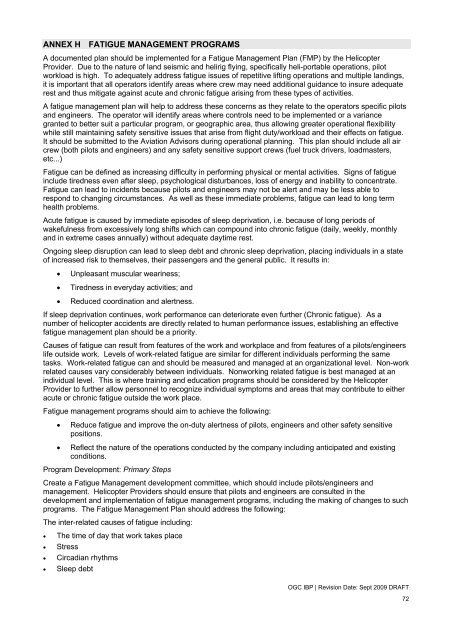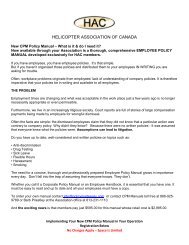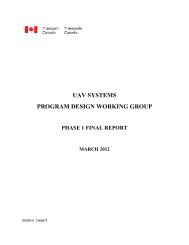HAC Oil & Gas IBP - Helicopter Association of Canada
HAC Oil & Gas IBP - Helicopter Association of Canada
HAC Oil & Gas IBP - Helicopter Association of Canada
You also want an ePaper? Increase the reach of your titles
YUMPU automatically turns print PDFs into web optimized ePapers that Google loves.
ANNEX H FATIGUE MANAGEMENT PROGRAMSA documented plan should be implemented for a Fatigue Management Plan (FMP) by the <strong>Helicopter</strong>Provider. Due to the nature <strong>of</strong> land seismic and helirig flying, specifically heli-portable operations, pilotworkload is high. To adequately address fatigue issues <strong>of</strong> repetitive lifting operations and multiple landings,it is important that all operators identify areas where crew may need additional guidance to insure adequaterest and thus mitigate against acute and chronic fatigue arising from these types <strong>of</strong> activities.A fatigue management plan will help to address these concerns as they relate to the operators specific pilotsand engineers. The operator will identify areas where controls need to be implemented or a variancegranted to better suit a particular program, or geographic area, thus allowing greater operational flexibilitywhile still maintaining safety sensitive issues that arise from flight duty/workload and their effects on fatigue.It should be submitted to the Aviation Advisors during operational planning. This plan should include all aircrew (both pilots and engineers) and any safety sensitive support crews (fuel truck drivers, loadmasters,etc...)Fatigue can be defined as increasing difficulty in performing physical or mental activities. Signs <strong>of</strong> fatigueinclude tiredness even after sleep, psychological disturbances, loss <strong>of</strong> energy and inability to concentrate.Fatigue can lead to incidents because pilots and engineers may not be alert and may be less able torespond to changing circumstances. As well as these immediate problems, fatigue can lead to long termhealth problems.Acute fatigue is caused by immediate episodes <strong>of</strong> sleep deprivation, i.e. because <strong>of</strong> long periods <strong>of</strong>wakefulness from excessively long shifts which can compound into chronic fatigue (daily, weekly, monthlyand in extreme cases annually) without adequate daytime rest.Ongoing sleep disruption can lead to sleep debt and chronic sleep deprivation, placing individuals in a state<strong>of</strong> increased risk to themselves, their passengers and the general public. It results in:Unpleasant muscular weariness;Tiredness in everyday activities; andReduced coordination and alertness.If sleep deprivation continues, work performance can deteriorate even further (Chronic fatigue). As anumber <strong>of</strong> helicopter accidents are directly related to human performance issues, establishing an effectivefatigue management plan should be a priority.Causes <strong>of</strong> fatigue can result from features <strong>of</strong> the work and workplace and from features <strong>of</strong> a pilots/engineerslife outside work. Levels <strong>of</strong> work-related fatigue are similar for different individuals performing the sametasks. Work-related fatigue can and should be measured and managed at an organizational level. Non-workrelated causes vary considerably between individuals. Nonworking related fatigue is best managed at anindividual level. This is where training and education programs should be considered by the <strong>Helicopter</strong>Provider to further allow personnel to recognize individual symptoms and areas that may contribute to eitheracute or chronic fatigue outside the work place.Fatigue management programs should aim to achieve the following:Reduce fatigue and improve the on-duty alertness <strong>of</strong> pilots, engineers and other safety sensitivepositions.Reflect the nature <strong>of</strong> the operations conducted by the company including anticipated and existingconditions.Program Development: Primary StepsCreate a Fatigue Management development committee, which should include pilots/engineers andmanagement. <strong>Helicopter</strong> Providers should ensure that pilots and engineers are consulted in thedevelopment and implementation <strong>of</strong> fatigue management programs, including the making <strong>of</strong> changes to suchprograms. The Fatigue Management Plan should address the following:The inter-related causes <strong>of</strong> fatigue including:The time <strong>of</strong> day that work takes placeStressCircadian rhythmsSleep debtOGC <strong>IBP</strong> | Revision Date: Sept 2009 DRAFT72









